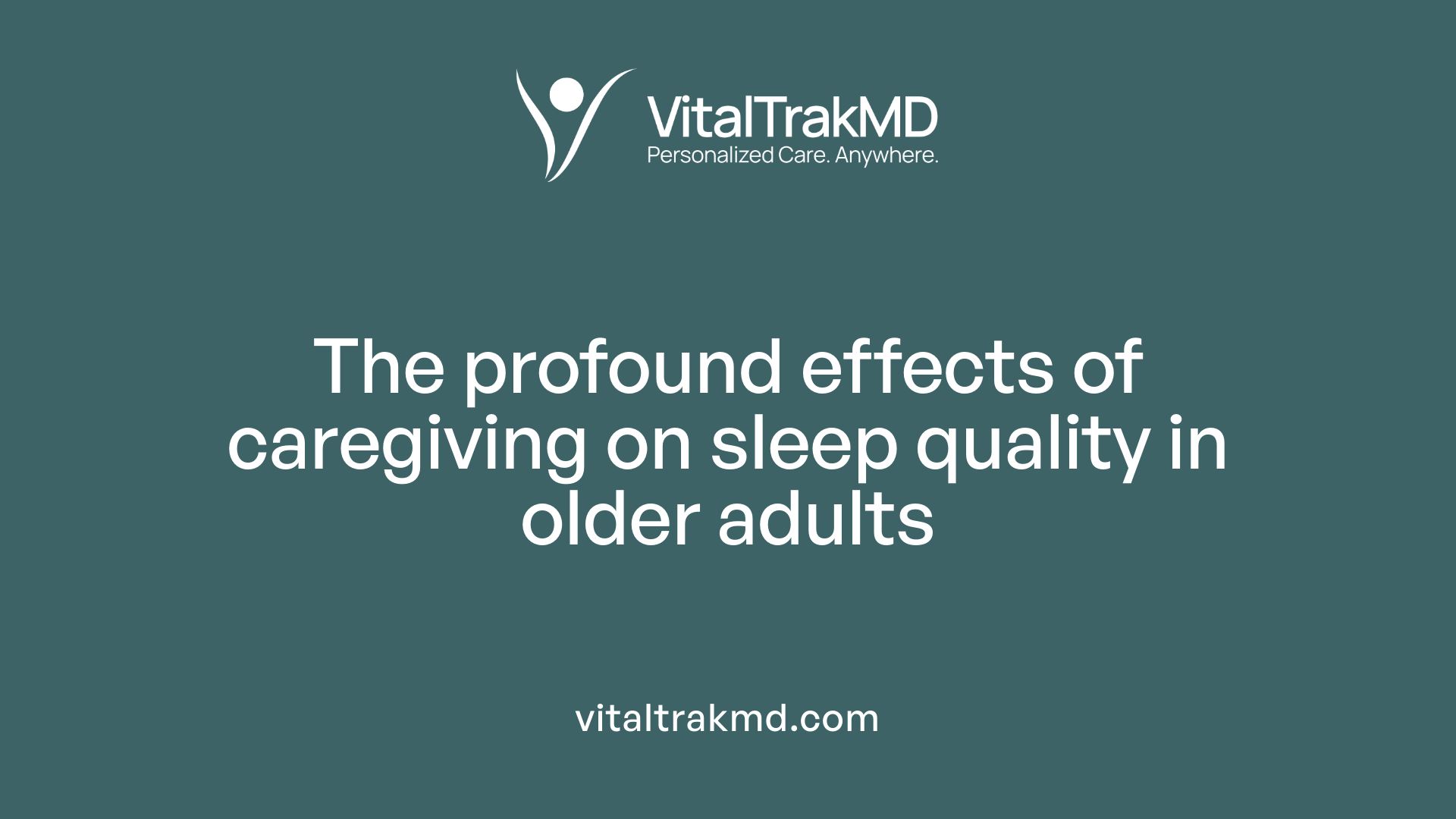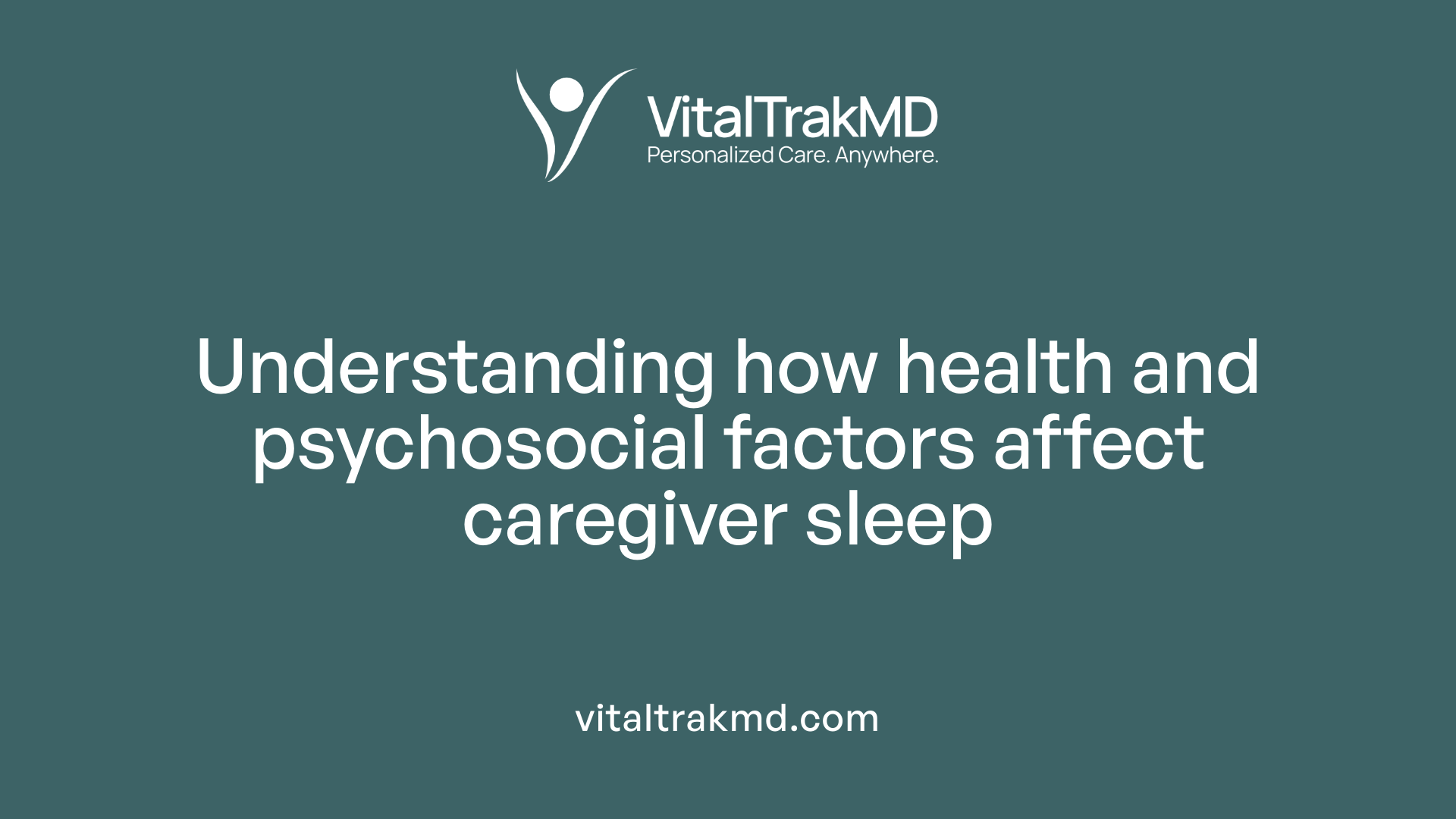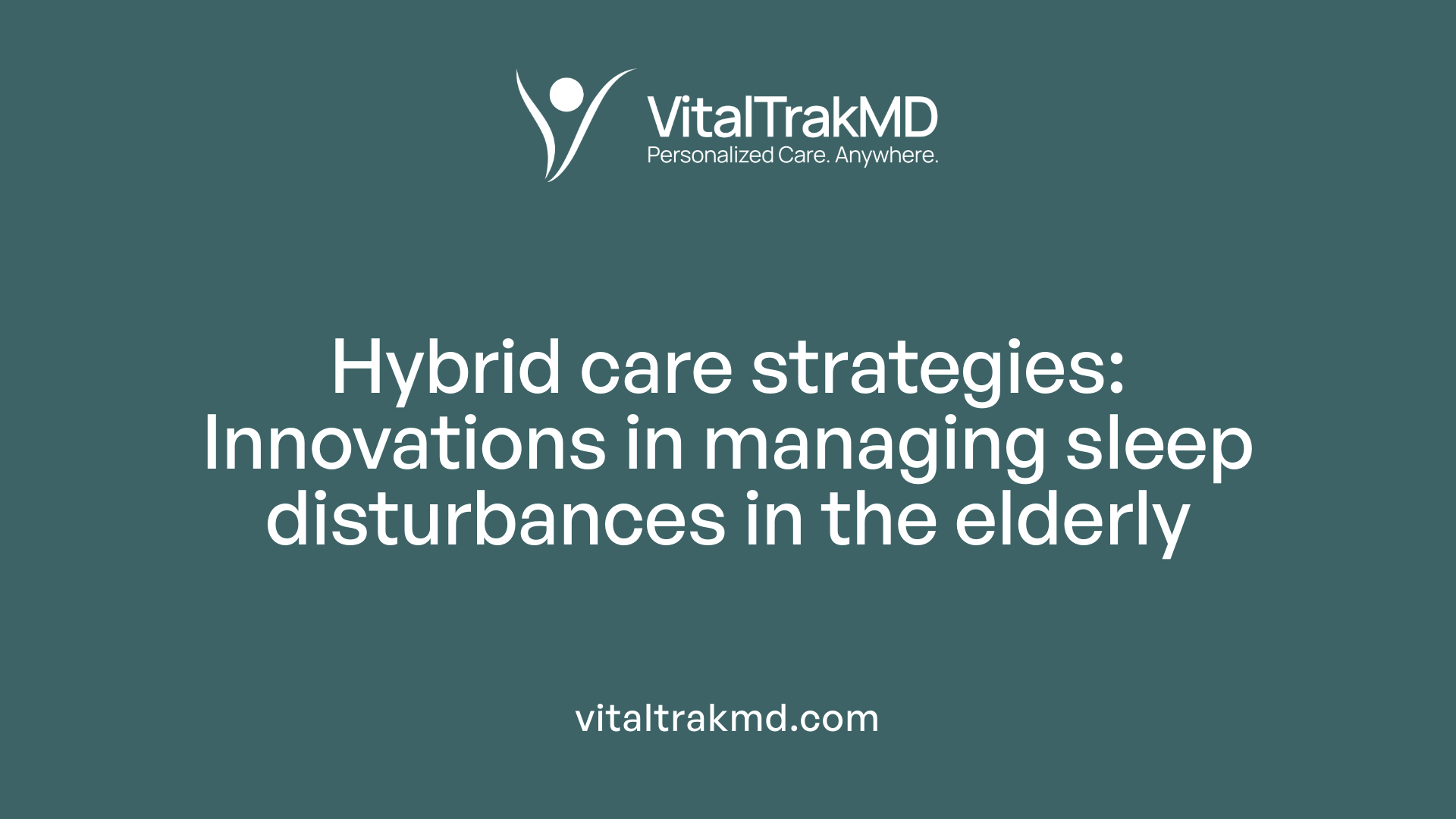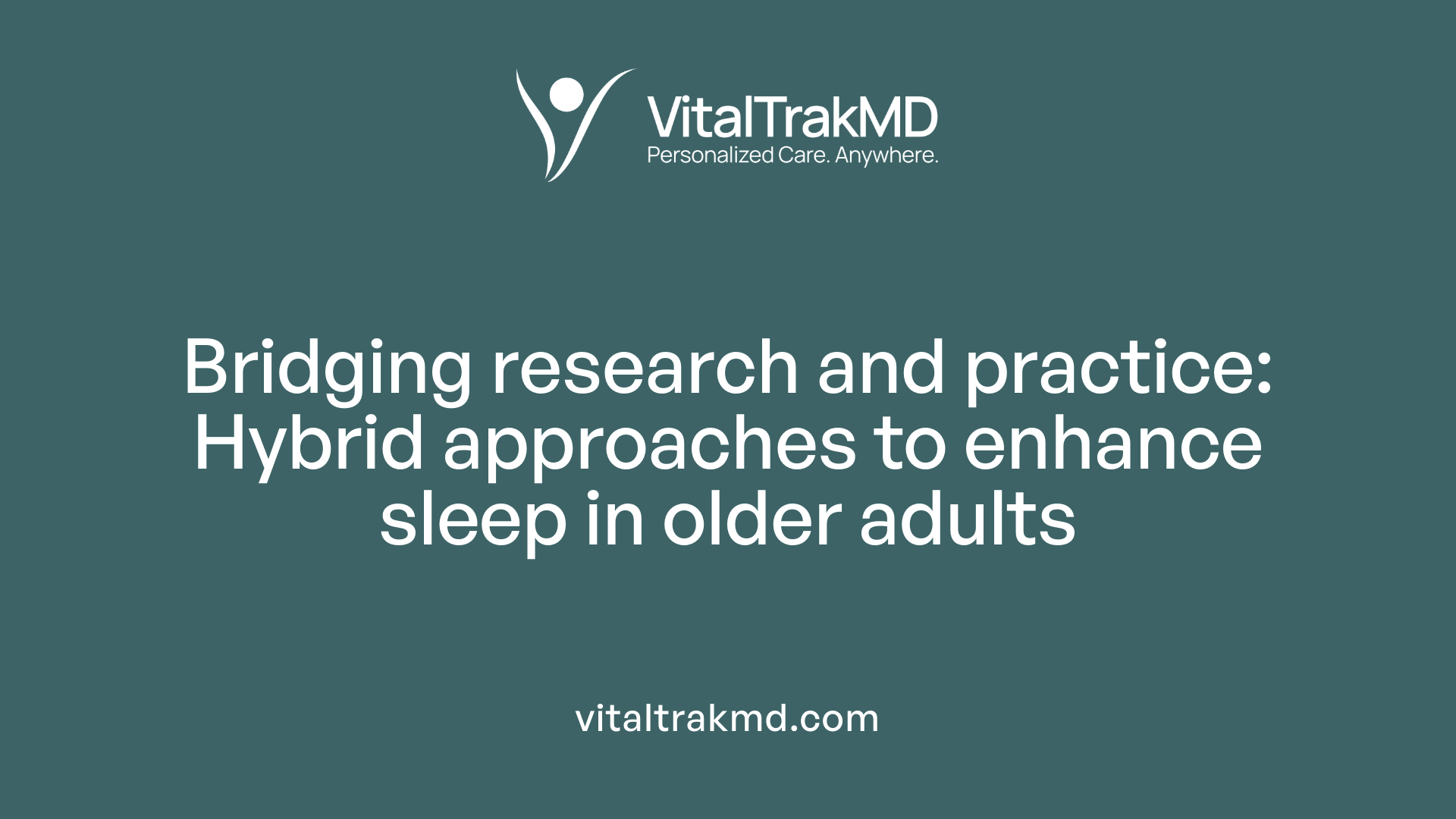The Role of Hybrid Care in Enhancing Sleep Quality for Aging Adults

Addressing Sleep Challenges in an Aging Population
As the global population ages, sleep disturbances among older adults have emerged as a pressing health concern. Traditional pharmacological treatments often fall short due to risks and side effects, prompting a shift toward hybrid care models that integrate technology, behavioral interventions, and personalized support. This article explores how hybrid care strategies play a crucial role in enhancing sleep quality among aging individuals, including those with dementia, and discusses the latest scientific findings, practical interventions, and future directions.
Understanding the Impact of Caregiving on Sleep in Elderly Adults

What is the prevalence of sleep disturbances in caregivers?
Sleep problems are highly common among caregivers of elderly and dementia patients. Studies show that up to 76% report poor sleep quality, reflecting the widespread nature of sleep disturbances in this group. Caregivers often experience issues such as difficulty falling asleep, frequent nighttime awakenings, and overall reduced sleep duration.
How do dementia-related behaviors influence caregiver sleep quality?
Caregivers of individuals with dementia frequently face sleep issues linked to problematic behaviors such as nocturnal awakenings and sleep disruptions. These behaviors can result in fragmented sleep, increased fatigue, and higher stress levels. The behavioral symptoms, including agitation or wandering at night, directly impact caregivers by causing difficulty in maintaining restful sleep.
What do objective measures reveal about sleep in caregivers?
Objective sleep assessments like actigraphy provide concrete data confirming these sleep issues. Results indicate that caregivers often have less than 7 hours of sleep, with frequent awakenings during the night and high levels of sleep fragmentation. These measures reveal shorter overall sleep duration, increased numbers of nocturnal awakenings, and more wakefulness after sleep onset, all of which contribute to poorer sleep quality.
Caregiving-related stress, emotional challenges, and physical exhaustion further exacerbate sleep disturbances. Factors such as gender (more common in women), age, employment status, and mental health symptoms like depression and anxiety are associated with worsened sleep. The importance of managing both the health of the caregiver and the behaviors of the care recipient is critical for improving sleep outcomes.
| Aspect | Findings | Additional Details |
|---|---|---|
| Prevalence of sleep issues | Up to 76% report poor sleep quality | High sleep disturbance rates among caregivers |
| Impact of dementia behaviors | Nocturnal awakenings, disruptions affect sleep | Behavioral symptoms directly disturb caregiver sleep |
| Objective sleep measures | Less than 7 hours sleep, frequent night awakenings | Confirm self-reports, highlight sleep fragmentation |
| Influencing factors | Gender, age, health status, caregiving burden | Mental health symptoms and physical health worsen sleep |
Understanding these dynamics helps in developing targeted interventions. Approaches such as behavioral sleep treatments, stress management, and accommodating specific caregiver needs can improve sleep quality, with potential benefits for overall health and caregiving capacity.
Factors Influencing Sleep in Caregivers and Care Recipients

What factors are associated with sleep disturbances among caregivers?
Research shows that several personal and situational factors contribute to sleep problems in caregivers. Women tend to experience more sleep disturbances than men, and age also plays a role, with older caregivers more likely to face sleep issues.
The relationship to the care recipient is important; spouses caregiving for partners with dementia often report worse sleep than other types of caregivers. Employment status further influences sleep, as full-time caregivers tend to have shorter sleep duration and more frequent disruptions.
How do symptoms like depression, anxiety, and fatigue affect caregiver sleep?
Depression and anxiety are strongly linked to poorer sleep quality among caregivers. These symptoms can cause difficulties falling asleep, frequent nocturnal awakenings, and decreased overall sleep duration. Fatigue, often stemming from long caregiving hours, also exacerbates sleep problems.
Psychosocial factors such as perceived burden and stress intensify sleep disturbances. High stress levels can lead to fragmented sleep and increased wakefulness after sleep onset. Additionally, caregivers experiencing high stress levels are more vulnerable to long-term health consequences.
What impact does physical health and BMI have on sleep quality?
Caregiver health status significantly influences sleep patterns. Poor general health, higher Body Mass Index (BMI), and symptoms of depression and anxiety correlate with reduced sleep quality. Caregivers with chronic health conditions often report shorter sleep duration and more sleep fragmentation.
How do the health characteristics of the care recipients influence caregiver sleep?
The health and behaviors of care recipients, especially those with neurodegenerative diseases like Alzheimer’s or Parkinson’s, affect caregiver sleep. For example, frequent nocturnal awakenings and disruptive behaviors in dementia patients often cause sleep interruptions in caregivers.
Behavioral symptoms such as agitation or hallucinations also increase caregiver stress and disturb sleep. Transitions such as hospital stays or worsening physical health in care recipients further add to caregiver sleep difficulties.
Are there strategies to address and improve sleep among caregivers?
Interventions focusing on sleep and mental health management show promise. Behavioral sleep treatments, including cognitive-behavioral therapy for insomnia (CBT-I), and strategies to reduce depression and anxiety can lead to better sleep outcomes.
Protective factors, like mindfulness and a strong sense of coherence, are associated with improved sleep duration and quality. Additionally, integrating physical activity, stress reduction techniques, and caregiver support programs can foster better sleep health.
What scientific evidence supports the effectiveness of hybrid care in managing sleep issues in older adults?
Scientific evidence supports the effectiveness of hybrid care approaches that integrate multiple therapeutic modalities, such as combining sleep interventions with physical activity, in managing sleep issues in older adults. Studies indicate that such combined strategies can lead to greater improvements in sleep quality and pain reduction, particularly among populations like those with osteoarthritis. Focus group research highlights the importance of tailoring physical activity components to individual needs, facilitating better adherence and outcomes. Non-pharmacologic therapies, including cognitive-behavioral therapy for insomnia (CBT-I), have demonstrated sustained benefits, while integrating physical activity may enhance these effects. Overall, a multidisciplinary, evidence-based hybrid approach that addresses both sleep disturbances and underlying health factors can significantly improve sleep and related health outcomes in the elderly.
| Factors | Effects | Notes |
|---|---|---|
| Gender | More common in women | Affects prevalence and severity |
| Age | Increased age correlates with sleep issues | Older caregivers face more disruptions |
| Relationship | Spouse caregivers experience worse sleep | Caregiving overlaps with emotional bonds |
| Symptoms | Depression, anxiety, fatigue worsen sleep | Associated with sleep fragmentation |
| Psychosocial | Burden and stress heighten disturbances | Chronic stress impacts sleep architecture |
| Health | Poor health, high BMI linked to poorer sleep | Comorbidities exacerbate problems |
| Care recipient behaviors | Nocturnal awakenings, behavioral issues | Neurodegenerative disease symptoms |
Understanding these influencing factors helps in designing targeted interventions to improve sleep health among caregivers and older adults, emphasizing the need for personalized care strategies.
Psychosocial and Health Factors in Caregiver Sleep Quality

How does health status influence sleep in caregivers?
The physical and mental health of caregivers plays a significant role in their sleep quality. Caregivers with poor health, higher body mass index (BMI), or symptoms of depression and anxiety are more likely to experience sleep disturbances. These issues can exacerbate sleep problems, leading to shorter sleep durations, frequent awakenings, and overall poorer sleep quality.
Furthermore, the health of the care recipient impacts caregiver sleep as well. Conditions like dementia, Parkinson’s disease, or other neurodegenerative disorders often involve behavioral and physical symptoms that disrupt both patient and caregiver sleep. Transitions such as hospital admissions or discharges also contribute to sleep disturbances.
Psychosocial factors, including perceived burden, stress levels, and emotional strain, further influence sleep patterns. Caregivers experiencing high stress or emotional difficulty tend to have more nighttime awakenings and insomnia, which can impair daytime functioning and overall health.
In addition, genetic factors can modify how caregiving stress affects sleep. For example, individuals with certain serotonin-related genotypes (like short allele carriers of 5-HTTLPR) may be more vulnerable to sleep problems under stress.
What nonpharmacological interventions within hybrid care can enhance sleep in older adults?
Within hybrid care models—combining in-person and remote healthcare modalities—various nonpharmacological approaches can effectively improve sleep for older adults. Environmental modifications are simple yet impactful. For instance, optimizing light exposure during the day can regulate circadian rhythms, while creating quiet, dark sleep environments minimizes disruptions.
Physical aids such as earplugs and eye masks are cost-effective tools that promote uninterrupted sleep. Relaxation techniques, including aromatherapy, guided imagery, massage, and acupuncture, can help reduce anxiety and promote relaxation, leading to better sleep.
Educating older adults about sleep hygiene is also essential. This includes maintaining consistent sleep schedules, avoiding stimulating activities before bedtime, and reducing nighttime noise and light.
Combining these strategies within a tailored, multimodal framework shows great promise. Customizing interventions to individual preferences and needs enhances their effectiveness and potential for sustained sleep improvements in older populations.
Integrating Hybrid Care into Sleep Management Strategies
How can hybrid care strategies be integrated into sleep management plans for elderly individuals?
Implementing hybrid care approaches offers a comprehensive way to address sleep disturbances among the elderly, including those with dementia. This involves blending personalized behavioral interventions with modern technology to optimize outcomes.
Personalized behavioral interventions such as cognitive-behavioral therapy for insomnia (CBT-I), light therapy, mindfulness practices, and sleep hygiene education form the foundation of non-pharmacological treatment. Tailoring these strategies to individual needs, especially considering medical conditions like dementia, ensures they are effective and sustainable.
Technology plays a crucial role in enhancing these interventions. Remote monitoring devices, such as actigraphy, allow clinicians and caregivers to track sleep patterns accurately. Virtual support systems—like online counseling, telehealth consultations, and group therapy—make these interventions more accessible, particularly for those in remote or caregiving-heavy settings.
Adapting strategies for dementia-related sleep issues involves considering the unique behavioral and physiological challenges of neurodegenerative diseases. For example, structured routines, environmental modifications, and caregiver education are incorporated into a flexible toolkit that responds to the changing needs of dementia patients.
Integrating medical oversight ensures safety and personalization. Care teams can use data from remote monitoring to adjust interventions, monitor medication effects, and identify emerging problems early. Combining these elements creates an adaptable, multimodal care system.
One effective model is virtual group sessions where caregivers and patients can learn and share experiences, promoting adherence and reducing feelings of isolation. Digital platforms also facilitate ongoing support, education, and motivation, which are vital for managing complex sleep issues.
This multimodal, hybrid approach not only improves sleep quality but also enhances daytime functioning and reduces caregiver burden. By minimizing dependency on sleep medications, often associated with adverse effects, it offers a safer, evidence-based pathway to better sleep health.
In sum, hybrid care strategies integrate the strengths of behavioral science and technological innovation, making personalized, flexible, and accessible sleep management a feasible goal for elderly populations and those caring for them.
Addressing Sleep Problems in Elderly Populations, Including Dementia Patients

How effective is hybrid care in addressing sleep disturbances among elderly populations, including those with dementia?
Hybrid care approaches have emerged as a promising strategy in managing sleep problems among older adults, especially those diagnosed with dementia. These approaches combine different non-pharmacological interventions, such as sleep hygiene education, light therapy, tailored physical activity, and environmental adjustments.
The goal of hybrid care is to improve the body's circadian rhythm, reduce agitation at night, and promote more restorative sleep. For dementia patients, where behavioral disturbances and sleep disruptions are common, integrating multiple modalities can be particularly beneficial.
Evidence from recent studies indicates that these combined methods can lead to improvements in sleep efficiency, decreased frequency of nighttime awakenings, and better behavioral outcomes. For example, light therapy targeting circadian misalignment, when used alongside physical activity and environmental modifications like reduced noise and adjusted lighting, has shown positive effects.
Furthermore, by emphasizing person-centered care—content tailored to individual preferences and routines—these interventions become more effective. This customization helps address specific symptoms and behavioral issues, leading to higher adherence and better outcomes.
While promising, current research also highlights the need for more standardized protocols and long-term studies to verify the sustained benefits of hybrid models. Nonetheless, the combined use of behavioral, environmental, and physiological strategies in a coordinated care framework provides a safer, holistic alternative to medication, which can carry significant risks for this vulnerable group.
Overall, integrated, multimodal treatments within a care team approach offer a comprehensive way to tackle sleep disturbances in elderly populations with dementia, enhancing quality of life and reducing caregiver burden.
Clinical and Research Perspectives on Hybrid Care for Sleep Improvement in Elders

What are the clinical and research perspectives on how hybrid care can improve sleep in older adults?
Emerging clinical and research insights highlight the potential of hybrid care models for enhancing sleep among older adults. Hybrid care typically combines digital interventions, such as digital cognitive behavioral therapy for insomnia (dCBT-I), with personalized physical activity programs. This integrated approach aims to tackle sleep disturbances while also promoting overall physical health.
Clinicians and researchers view this framework as particularly promising because it offers tailored, sustainable strategies that can adapt to individual needs. For example, patients with osteoarthritis can benefit from customized exercises and sleep management techniques supported by digital tools and regular coaching.
One such example is the 'Move & Snooze' program, which emphasizes ongoing support, personalized feedback, and empathetic communication. The coaching component helps sustain motivation, address barriers, and reinforce healthy habits, thereby improving adherence.
Several facilitators enhance the effectiveness of hybrid care. These include frequent motivational communication, accountability mechanisms, health education, and user-friendly digital platforms. Addressing barriers—such as complexity in healthcare interactions, recording burdens, and technology literacy challenges—is also crucial.
Current pilot studies and ongoing research suggest that hybrid models can significantly optimize sleep outcomes by simultaneously improving sleep quality and physical activity levels. These programs show promise in fostering long-term behavior change and overall well-being.
The broader research focus is now shifting toward evaluating the implementation, scalability, and sustainability of such models. Future studies aim to refine these interventions, explore diverse populations, and establish robust evidence for their wider clinical adoption.
In summary, the future of sleep improvement in older adults may well depend on integrated, person-centered hybrid strategies that seamlessly blend digital innovation with tailored physical health support, guided by ongoing research and clinical insights.
The Future of Hybrid Care in Sleep Management for Older Adults
How do emerging technologies and innovations shape sleep care for the elderly?
Advancements in technology are transforming sleep management by offering innovative tools like wearable sleep trackers, body vibrometers, and communicative robots. These technologies enable continuous, non-invasive monitoring of sleep patterns, which is crucial for elderly individuals who often have complex health needs.
Wearable devices collect real-time data on sleep duration, fragmentation, and quality, providing objective insights beyond traditional self-reporting. Body vibrometers can detect subtle movements during sleep that may indicate disturbances, while robots can assist in responding promptly to nocturnal issues, such as wandering or agitation.
These innovations also improve safety by alerting care staff immediately to sleep-related problems, reducing risks such as falls or unnoticed health deterioration. Moreover, they facilitate personalized interventions by visualizing patterns, allowing healthcare providers to refine treatment plans tailored to individual needs.
What are the long-term effects and sustainability of hybrid sleep care models?
Implementing hybrid models that combine traditional caregiving with new technologies has the potential to enhance sleep quality over the long term. By providing accurate, continuous data, these models support early detection of sleep disturbances linked to conditions like dementia and Parkinson’s disease.
Sustainability depends on the integration of these innovations into existing healthcare systems and ensuring they are cost-effective and user-friendly. As technology becomes more affordable and accessible, health services can adopt these tools more widely, reducing reliance on pharmacological interventions and minimizing caregiver burden.
Furthermore, incorporating feedback from caregivers and patients can help sustain engagement and adherence to new approaches. Over time, such models could lead to improved health outcomes, reduced hospitalization rates, and enhanced quality of life for elderly individuals.
What policy implications and integration strategies are needed for successful implementation?
Integrating hybrid sleep care into healthcare systems requires supportive policies that promote research, funding, and education. Policymakers should prioritize establishing standards for the use of emerging sleep technologies, including safety and privacy regulations.
Training healthcare providers and caregivers on the effective use of these tools is essential. Policies that incentivize health facilities to adopt technology-driven solutions can facilitate widespread implementation.
Additionally, integrating data from hybrid models into electronic health records ensures cohesive and comprehensive care planning. Reimbursing telehealth and remote monitoring services through insurance schemes can also promote adoption.
Overall, a multi-stakeholder approach involving clinicians, technologists, patients, and policymakers is necessary to leverage the full potential of hybrid sleep management models for aging populations.
Conclusion: Embracing Hybrid Care for Better Sleep Outcomes
What are the benefits of hybrid care in sleep management for older adults?
Hybrid care combines traditional in-person healthcare with digital health solutions, offering a flexible and personalized approach to sleep improvement. This method leverages technology such as online cognitive-behavioral therapy for insomnia (dCBT-I), combined with tailored physical activity programs, to address multiple factors impacting sleep.
Research indicates that this integrated strategy enhances adherence by providing ongoing support, education, and motivation. As a result, older adults are more likely to maintain consistent sleep practices, leading to improved sleep quality, reduced sleep disturbances, and overall better health outcomes.
Clinicians and caregivers benefit from a more comprehensive perspective that combines medical, behavioral, and lifestyle interventions. This holistic approach also enables careful monitoring and adjustment based on individual responses, thus increasing the likelihood of sustained benefits.
What are the implications for practice and policy?
The adoption of hybrid sleep care models requires changes in healthcare delivery systems to incorporate digital tools alongside traditional services. Policymakers should promote policies that encourage integration, including reimbursement models that support telehealth options and digital health interventions.
Practitioners need training in digital health application and in developing personalized, culturally sensitive plans that suit diverse older adult populations. Hospitals and nursing homes can implement pilot programs integrating hybrid sleep management strategies, with regular assessments to evaluate effectiveness.
This approach also emphasizes patient-centered care, respecting individual preferences, environments, and resource access, which can reduce healthcare disparities.
What is the call for ongoing research?
Although promising, current evidence about hybrid sleep care in older adults is evolving. Further high-quality research, including randomized controlled trials, is needed to confirm the effectiveness, acceptability, and cost-efficiency of these models.
Future studies should explore long-term outcomes, optimal delivery formats, and scalability across different healthcare settings. Investigating barriers to adoption and adherence, especially among vulnerable populations, will be crucial for tailoring interventions.
Researchers should also assess the impact of hybrid care on comorbid conditions, cognitive decline, and quality of life, using both subjective and objective measures such as actigraphy and neuropsychological testing.
In summary, embracing hybrid care models offers a promising avenue to improve sleep health and overall well-being among older adults. It calls for collaborative efforts between clinicians, researchers, policymakers, and technology developers to realize its full potential.
Looking Ahead: Optimizing Sleep Through Hybrid Innovation
The integration of hybrid care strategies into sleep management for aging adults marks a significant advancement in healthcare. Evidence indicates that combining traditional interventions with cutting-edge technology and personalized approaches can effectively address complex sleep disturbances, including in vulnerable populations like those with dementia. Ongoing research, innovative technologies, and a multidisciplinary approach will be essential in realizing the full potential of hybrid care. Policymakers, clinicians, and caregivers must collaborate to develop sustainable frameworks that promote sleep health, enhance quality of life, and reduce health risks associated with poor sleep in older adults. As the field evolves, embracing hybrid solutions offers a promising pathway toward healthier aging and better sleep outcomes for all.
References
- How Adult Caregiving Impacts Sleep: a Systematic Review
- Sleep Problems in Caregivers for Older Adults - PMC
- Nonpharmacological interventions to improve sleep in ...
- Interventions that Improve Sleep in Caregivers of Adult ...
- Strategies for Managing Sleep Disorders in Older Adults
- Enhancing sleep quality for nursing home residents with ...
- Development of a hybrid sleep and physical activity ...
- Sleep In Older Adults: Normative Changes ...
Recent articles
Want to Feel Better and Live Healthier?
Join hundreds of patients taking control of their health with personalized care that fits their life – not the other way around.
Rated 4.8/5 by 32+ customers







